Turkey and its Postage Stamps
23. Sep. 2009
When the Osmanli introduced the stamp in 1863, it was with a price system which was quite similar to the Danish predecessor of the unit rate: The price was calculated in "route hours" dependent on how long time it took the postal service to cover the distance from sender to recipient. The more inaccessible the ground was, the more expensive the letter became, and consequently, the possibilities of creating and maintaining trade agreements varied a lot dependent on one's place of residence.
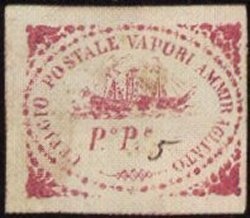
Stamp issued by the Turkish Steamship Admiralty, 1859.
The First Stamps
Already in 1859, the Turkish Steamship Admiralty introduced a stamp to be used on letters sent between the Osmanli ports. The stamp functioned as a postage stamp for all values: Under the steamship in the middle of the stamp the text read "Po Po" (Porto Piastre) and next to this the required value was simply added in handwriting. Today these stamps are rather rare and popular collector's items.
The first series of stamps to be used throughout the empire was printed in lithography in Istanbul and appears therefore as more primitive than the first Danish stamps which were printed in letterpress printing. The stamps were imperforated and in order to be valid they needed a coloured guarantee mark at the bottom. The next series from 1865 had a different appearance: It was perforated and the stamps were printed more professionally in letterpress printing. Until 1913, all motifs were symbols of either Islam or "Tughra" - the symbol of the sultan.
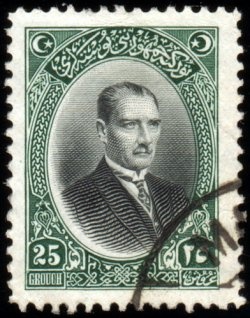
Turkish stamp featuring Mustafa Kemal Atatürk, 1926. Atatürk was already on a stamp in 1924, but at that time he had to share the space with a Turkish landscape.
Collapse and Republic
The Ottoman Empire got the nick name "the Sick Man of Europe" during the last half of the 19th century. The country was declining and in a state of national bankruptcy in the 1870's. During World War I the empire built alliances with Germany and Austria-Hungary, and the weakened empire had to conclude an armistice with the victorious allied powers in 1918.
In 1923, the independent republic of Turkey was declared with Mustafa Kemal Atatürk as president. The goal was a democratic, independent, industrial state according to western model. The first stamps after the foundation of the republic featured the parliament, but already in 1924, Atatürk appeared on a stamp for the first time. The stamps spread the message of the creation of the republic and its new leader.
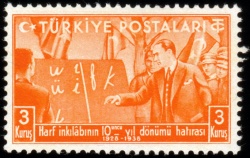
Turkish stamp from 1938 commemorating the 10th anniversary of the introduction of the Roman alphabet. On the stamp Atatürk is presenting the new letters.
Changes and the Time after Atatürk
The motifs of Turkish stamps reflected the changes made by Atatürk during his time in office: In 1924 the Sharia legislation was abolished in favour of western law, in 1925 the Gregorian calendar and the metric system were introduced, and in 1928 the Arabic alphabet was replaced by the Roman alphabet and Islam was abolished as state religion. Women were enfranchised in 1934, and the following year Ankara hosted a large women's conference - Turkey was in the front rank in the struggle for equality - even though there was but one ruler.
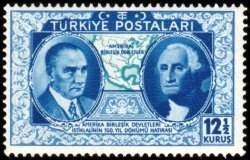
Turkish stamp issued on the occasion of the 150th anniversary of the American Declaration of Independence with motif of Atatürk and the American President George Washington, 1939.
Atatürk died in 1938, and the year after he was lionized on a stamp together with the first American President, George Washington, The occasion was the 150th anniversary of the first American president, but the comparison was unmistakable: Turkey had become a secularized democracy and its creator was on a par with the father of the United States George Washington. There were certain common features with the largest democracy in the world!
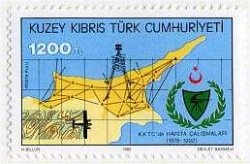
Stamp from 1992. The map shows the northern part of Cyprus which was conquered by Turkey.
Cyprus and "the Illegal Postage Stamps"
In 1974, a Greek-Cypriot military coup took place on Cyprus with the purpose of incorporating the island in the republic of Greece. In order to protect the Turkish-Cypriot citizens on the island Turkey launched a military offensive resulting in an occupation of northern Cyprus under protest from among others the UN. Already in the early 1960's Cyprus had been the object of conflicts between Greece and Turkey and as a result of this the island had got its own postal service in 1963. In 1973, the Turkish part of the postal service on Cyprus issued a postage stamp on the occasion of the 50th anniversary of the Turkish republic, but the stamp was only for use on Cyprus itself. It was not until after the Turkish invasion in 1974 that it became possible to use the stamps on international letters.
Stamps issued by the Turkish-Cypriot postal service have appeared in an even flow since 1975. The stamps are not recognized by the Universal Postal Union as only Turkey recognizes the occupied part of Cyprus as an independent, stamp-issuing area. The Turkish Republic of Northern Cyprus was proclaimed in 1983. Today, the southern part of Cyprus is a member of the EU, but that is not the case with the northern part of the island which has not yet been recognized as an independent republic. Therefore the stamps from northern Cyprus have nothing to do with the other existing Cypriot stamps.
Stamps not just for Postage
The Turkish stamps are an example of postage stamps being used for other purposes than just a means of payment for sending letters. They are also used for political manifestations and national assembling. At Post & Tele Museum we have asked a number of new Danes to tell about their native country on basis of their native country's stamps and let the meeting with the Danish stamps be the subject of a dialogue.
Post & Tele Museum are exhibiting Turkish stamps from the period 1863-2002 in the stamp cabinet until 31st December 2009.
Sources
"The Stamps of Turkey" by Adolf Passler. The Royal Philatelic Society, London.1938.
"Notes on Cancellations of Turkish Arabia" by Tomkins, T.L.C. John Huxley Stamps, Ltd. London.
"The Stamp Atlas" by Stuart Rossiter and John Flower. MacDonald & Co (Publishers) Ltd., London & Sydney. 1986.
This article may be copied or quoted with MuseumsPosten, Post & Tele Museum as source.
Comment this article
Only serious and factual comments will be published.
Other comments for this article
Jeg genkender tydeligt dit problem! Jeg har selv brugt AFA katalogernes oversættelse, men det er ikke helt nemt. Bedste jeg har fundet er: http://danielschereck.com/wp2002arabia/wp-arabicnumbers.htm ;
Du kan på biblioteket låne et frimærkekatalog og selv se nærmere på prisniveauet. AFA Frimærkekatalog, Østeuropa bind 2 er inkl. Osmanerriget. Bemærk at priserne i kataloget er vejledende.
Janus, Post & Tele Museum